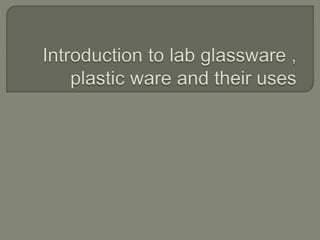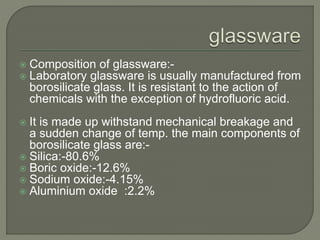Glassware
- 2. ÔÇû Composition of glassware:- ÔÇû Laboratory glassware is usually manufactured from borosilicate glass. It is resistant to the action of chemicals with the exception of hydrofluoric acid. ÔÇû It is made up withstand mechanical breakage and a sudden change of temp. the main components of borosilicate glass are:- ÔÇû Silica:-80.6% ÔÇû Boric oxide:-12.6% ÔÇû Sodium oxide:-4.15% ÔÇû Aluminium oxide :2.2%
- 3. Beaker These have capacities from 5to 5000ml. They are generally in a square form , which is cylindrical and has a spout. These are used mainly for preparation of solutions.
- 4. ÔÇû These have capacities of 25- 5000ml. ÔÇû These are of different types : ÔÇû Conical flask:- ÔÇû These are used for performing titration and for boiling the solution, since evaporation is min. because of the conical shape .
- 5. ÔÇû Flat bottomed flask:- ÔÇû These are mainly used for heating liquids. ÔÇû Round bottomed flasks:- ÔÇû These can withstand higher temp. They may be heated in a naked flame. ÔÇû Volumetric flasks:- ÔÇû They are flat bottomed pear shaped vessels with long narrow necks with a specific vol. mark and fitted with a stopper. These are mainly used to make final vol. of the reagent very accurately.
- 6. Flat bottomed flask Round bottomed flasks Volumetric flasks
- 7. ÔÇûThey are available in 10- 2000ml. ÔÇûThey are used to measure quantity of the liquid. A high degree of accuracy is not possible because of wide bore.
- 8. ÔÇû They are available in 25- 5000ml capacities. ÔÇû They are cylindrical have narrow necks and fitted with stopper made up of plain glass or amber colored glass . ÔÇû Amber colored bottles are used to store certain reagents which are flammable and light sensitive .
- 9. ÔÇû They are used for measuring variable quantities of liquid. They are available in capacities of 1 to 100 ml. ÔÇû They are long graduated tubes of uniform bore and are closed at the lower end by means of glass stopcock. These are used for titration and also to dispense corrosive reagents.
- 10. ÔÇûThese are available in variety of range for the separation of:- ÔÇûSolids from liquids ÔÇûLiquid from liquids ÔÇûFor pouring liquid , chemicals or solutions into a container ÔÇûThe commonly used funnels are of diameter of 50, 65,75, and 100 mm.
- 11. ÔÇû These are of uniform thickness & withstand mechanical & thermal shocks. Tubes with rim are preferred when reagent in a tube is directly heated on the flame with test tube holder. ÔÇû The commonly used test tube in biochemistry is 15√ó125 mm
- 12. These are used for dispensing controlled quantities of liquids and are classified as:- Graduated pipettes  Serological  Mohar Volumetric pipettes
- 13. ÔÇûThese are available from 0.1 to 10ml capacities. The graduation are durable, resistant to chemical attack and normal washing. ÔÇûThey are available both in class A and class B accuracies. Class A pipettes are very accurate and used for quantitative determination.
- 14. ÔÇûThese are graduated pipettes marked up to the tip. These are mainly used for pipetting reagents . However 0.1 & 0.2 ml pipettes are used for pipetting specimen like blood ,serum, plasma as well as different standards. These are mainly used to perform serological tests.
- 15. ÔÇûThese are graduated above the tip so that even if the tip is broken these can be used for their full capacities. The use is the same as that of serological pipettes . ÔÇûThese are not convenient to perform serological test.
- 16. ÔÇûThese pipettes are not graduated but designed specifically with a central bulb to designed specific quantity of the specimen. These pipettes are more accurate.
- 17. ÔÇûThese pipettes can be prepared in the laboratory by using glass tubing. These are used by attaching rubber teats for the separation of serum & plasma from the cells. In qualitative determination , few drops of specimen are required to perform a test.

















